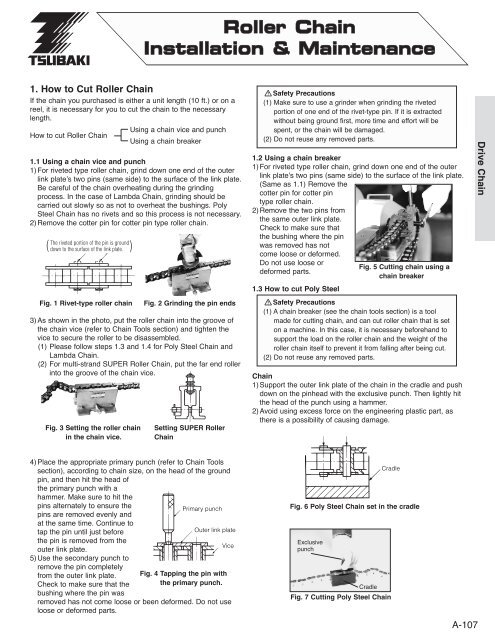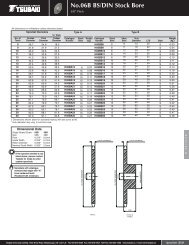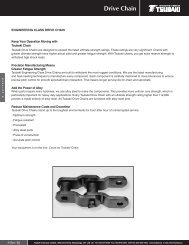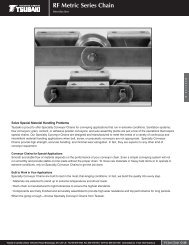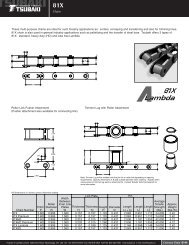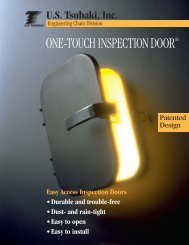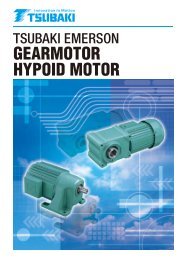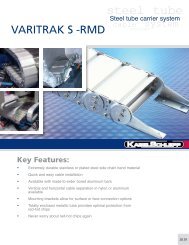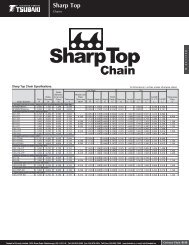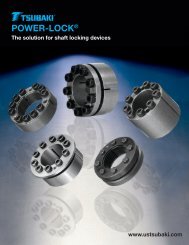Roller Chain - Tsubaki
Roller Chain - Tsubaki
Roller Chain - Tsubaki
You also want an ePaper? Increase the reach of your titles
YUMPU automatically turns print PDFs into web optimized ePapers that Google loves.
<strong>Roller</strong> <strong>Chain</strong>Installation & Maintenance1. How to Cut <strong>Roller</strong> <strong>Chain</strong>If the chain you purchased is either a unit length (10 ft.) or on areel, it is necessary for you to cut the chain to the necessarylength.How to cut <strong>Roller</strong> <strong>Chain</strong>1.1 Using a chain vice and punch1) For riveted type roller chain, grind down one end of the outerlink plate’s two pins (same side) to the surface of the link plate.Be careful of the chain overheating during the grindingprocess. In the case of Lambda <strong>Chain</strong>, grinding should becarried out slowly so as not to overheat the bushings. PolySteel <strong>Chain</strong> has no rivets and so this process is not necessary.2) Remove the cotter pin for cotter pin type roller chain.The riveted portion of the pin is ground( down to the surface of the link plate. )Fig. 1 Rivet-type roller chain3) As shown in the photo, put the roller chain into the groove ofthe chain vice (refer to <strong>Chain</strong> Tools section) and tighten thevice to secure the roller to be disassembled.(1) Please follow steps 1.3 and 1.4 for Poly Steel <strong>Chain</strong> andLambda <strong>Chain</strong>.(2) For multi-strand SUPER <strong>Roller</strong> <strong>Chain</strong>, put the far end rollerinto the groove of the chain vice.Fig. 3 Setting the roller chainin the chain vice.Using a chain vice and punchUsing a chain breakerFig. 2 Grinding the pin endsSetting SUPER <strong>Roller</strong><strong>Chain</strong>0Safety Precautions(1) Make sure to use a grinder when grinding the rivetedportion of one end of the rivet-type pin. If it is extractedwithout being ground first, more time and effort will bespent, or the chain will be damaged.(2) Do not reuse any removed parts.1.2 Using a chain breaker1) For riveted type roller chain, grind down one end of the outerlink plate’s two pins (same side) to the surface of the link plate.(Same as 1.1) Remove thecotter pin for cotter pintype roller chain.2) Remove the two pins fromthe same outer link plate.Check to make sure thatthe bushing where the pinwas removed has notcome loose or deformed.Do not use loose ordeformed parts.1.3 How to cut Poly SteelFig. 5 Cutting chain using achain breaker0Safety Precautions(1) A chain breaker (see the chain tools section) is a toolmade for cutting chain, and can cut roller chain that is seton a machine. In this case, it is necessary beforehand tosupport the load on the roller chain and the weight of theroller chain itself to prevent it from falling after being cut.(2) Do not reuse any removed parts.<strong>Chain</strong>1) Support the outer link plate of the chain in the cradle and pushdown on the pinhead with the exclusive punch. Then lightly hitthe head of the punch using a hammer.2) Avoid using excess force on the engineering plastic part, asthere is a possibility of causing damage.Drive <strong>Chain</strong>4) Place the appropriate primary punch (refer to <strong>Chain</strong> Toolssection), according to chain size, on the head of the groundpin, and then hit the head ofthe primary punch with ahammer. Make sure to hit thepins alternately to ensure thepins are removed evenly andat the same time. Continue totap the pin until just beforethe pin is removed from theouter link plate.5) Use the secondary punch toremove the pin completelyfrom the outer link plate.Check to make sure that thebushing where the pin wasPrimary punchOuter link plateFig. 4 Tapping the pin withthe primary punch.removed has not come loose or been deformed. Do not useloose or deformed parts.ViceCradleFig. 6 Poly Steel <strong>Chain</strong> set in the cradleExclusivepunchCradleFig. 7 Cutting Poly Steel <strong>Chain</strong>A-107


